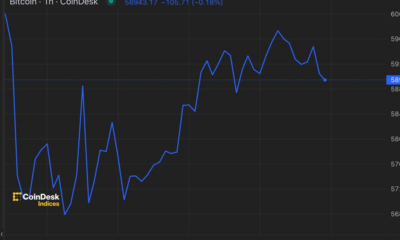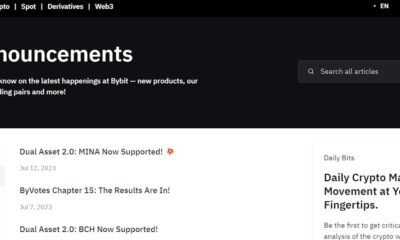News
Interview with Mark Gofaizen, Senior Partner at Gofaizen & Sherle

Continue reading U.TODAY
Google News
There is a lot to consider regarding the potential effects of the upcoming Markets in Crypto-Assets (MiCA) regulation on the cryptocurrency market. Mark Gofaizen, an experienced cryptocurrency regulatory compliance specialist, is here today to share his thoughts. Gofaizen is a senior partner at Gofaizen & Sherle and has actively assisted cryptocurrency companies with intricate regulatory changes. We will discuss the implications of MiCA for cryptocurrency service providers, the opportunities and challenges it raises, and how companies can best prepare for this new regulatory landscape.
U.Today: Can you briefly explain what MiCA is for our readers?
Mark Gofaizen: MiCA, or Markets in Crypto-Assets, is a regulatory framework aimed at harmonizing rules for crypto companies and assets within the European Union. This is a key development for cryptocurrency service providers, including exchanges, wallet services, and payments providers, among others. MiCA seeks to establish a secure and transparent operating environment in the crypto community, prioritizing customer protection first. This framework also highlights the growing relevance of the crypto economy to the overall economic health of the EU. In essence, MiCA is a set of rules that brings the management of crypto finance closer to that of traditional finance, covering areas such as capital requirements, anti-money laundering and terrorist financing (AML/CTF), customer data collection, protection, compliance and more .
The MiCA (Markets in Crypto-Assets) regulation will come into force on December 30, 2024. However, companies will be given a transition period extending until May 2025 to fully comply with the new requirements. This transition phase is critical for cryptocurrency service providers to adapt their operations and ensure full compliance with the MiCA global regulatory framework.
U.Today: What are the most significant changes MiCA will bring to crypto regulations in the EU?
Mark Gofaizen: Firstly, the capital requirements stipulate that companies must have a minimum paid-up capital of €125,000, which is substantial for small and medium-sized enterprises (SMEs). Second, AML/CTF requirements imply, among other things, the need for more highly trained personnel, additional reporting and increased documentation. Customer identification is also a significant aspect. Data protection is another important issue on the agenda. As an owner or manager of an SME, you need to stay in line with all regulatory changes, keep track of important dates, prepare reports and work closely with authorities. The good news is that these changes are not immediate and companies have a transition period to hire staff and find all the necessary partners. However, this is crucial for the operational part of the business: it consumes a lot of time and resources that could otherwise be allocated to business development. Our goal as a consultancy firm is to take on most of these tasks. We handle the paperwork, legal aspects, hiring and accounting and also assist in finding an office.
U.Today: How will these new regulations affect small and medium-sized crypto businesses?
Mark Gofaizen: I am actively collaborating with crypto-asset service providers (CASPs) in the EU, particularly in Lithuania, which is a key market. I have observed that most companies are willing to operate under MiCA regulations. However, this will inevitably have an impact on the cryptocurrency market. Over the next three to five years, we can expect to see a consolidation of the market, resulting in fewer but larger companies. MiCA is designed to improve the security and transparency of the cryptocurrency market for consumers. However, this will also increase the barrier to entry, requiring newcomers to have more resources from the start. The market is evolving into a more mature and complex phase and will certainly look very different in five years.
U.Today: Why is legal support crucial for companies facing these new regulations?
Mark Gofaizen: Cryptocurrency market regulation has always been complex and requires in-depth knowledge of each country’s laws to navigate various jurisdictions and languages. Typically, companies have two options: build an in-house legal team or hire a legal services provider in a crucial jurisdiction. With the rapid transformation of European cryptocurrency regulations, solid legal support has become increasingly vital. Timeliness and accuracy are essential, as is maintaining communication with local authorities. During this transition phase, companies need reliable legal guidance to ensure compliance and reliability, as well as the ability to provide 24-hour support.
U.Today: What are some practical steps companies can take to adapt to these new rules?
Mark Gofaizen: Many companies are making the transition to comply with MiCA regulations. In Lithuania, we benefit from cooperative authorities who are gradually aligning market conditions with MiCA standards. This change brings the regulatory framework for crypto-asset service providers (CASPs) increasingly in line with that of traditional financial institutions such as banks.
When it comes to actionable measures, the first decision for any company is whether to continue operating in the cryptocurrency market under strict rules, which include thorough oversight and reporting. The second step is to prepare your company to meet the basic requirements: guarantee the minimum paid-up capital, meet management qualifications and obtain the necessary licenses. Next, it is critical to evaluate how these changes will affect operational processes and determine the additional staff needed to comply. This leads us to consider internal company training versus external recruiting.
U.Today: Do you think we will see many smaller companies merge or go out of business due to higher regulatory costs?
Mark Gofaizen: Many companies are able to adhere to MiCA regulations. However, current trends suggest that some may choose to shift their primary markets. This could involve targeting different market areas or moving to more accommodating jurisdictions. As a result, we may see companies migrating from the EU to find favorable conditions in places like the United Arab Emirates, El Salvador, Canada, among others. Despite this, the EU market has substantial value for these companies and we can anticipate market consolidation. Major market players are likely to benefit from these regulatory changes. For many smaller businesses, this period represents an opportunity to evolve their business models and position themselves for growth over the next three to five years.
U.Today: Despite stricter regulations, what opportunities do you see for growth in the EU cryptocurrency market?
Mark Gofaizen: Identifying opportunities amidst these changes is truly fascinating. As mentioned, it is a time of growth and strategic reevaluation. The more mature, secure and stable the cryptocurrency market becomes, the more competitive it will be compared to the traditional financial sector. Large companies recognize this and have created internal crypto departments to keep up with current trends. However, I believe that the most valuable ideas and projects will emerge from small and medium-sized enterprises (SMEs).
U.Today: What are the current demands of the cryptocurrency industry for the future workforce?
Mark Gofaizen: As professionals, we are applying our traditional financial expertise to create a new crypto economy. The industry’s current priority is the recruitment of anti-money laundering officers and compliance professionals, reflecting the maturation of the industry. This dynamic field offers the satisfaction of seeing direct results and influencing business outcomes. We have launched an educational initiative to train graduates in AML, thus facilitating the entry of new talent into crypto finance. Furthermore, there is a growing demand for legal experts. Lawyers with a solid understanding of traditional finance are critical to the continued development and evolution of the cryptocurrency industry.
U.Today: Can you share an example of how your company helped a client successfully navigate regulatory challenges?
Mark Gofaizen: We have been helping clients navigate the regulatory changes that accompany the growth of the cryptocurrency industry for many years. This was the case when Estonia changed its main law on VASPs in 2020, and again in 2022. We also assisted Lithuania and Poland when their regulators made important legislative changes. Our support included meeting capital raising requirements, updating internal procedural rules, amending AML/KYC policies, providing regulators with company descriptions and much more. In short, we have extensive experience guiding and adapting businesses during times of regulatory change.
As for MiCA, there are no completed cases on the market yet, so there are no guidelines from the regulator. However, there are European standards that indicate what regulators expect in terms of documentation. We are already helping customers start preparing their documentation according to MiCA standards. This mainly concerns electronic money issuers (EMI licenses) and payment service providers. We understand regulators’ expectations regarding cybersecurity policies, business plans, business continuity plans, risk assessments and more. As a result, we are already working with customers to prepare a set of documents that will help them launch much more quickly once the final MiCA guidelines are issued.
U.Today: What do you think will be the biggest changes in the cryptocurrency industry in the coming years and how should companies prepare?
Mark Gofaizen: MiCA represents the first major turning point in the EU. I believe this framework could influence other markets, especially in North America. Another significant change is the growing interest and investment from institutional investors. When established financial institutions engage in the crypto space, they introduce a level of legitimacy and stability, potentially leading to broader adoption.
In terms of blockchain technology, we are seeing improvements in scalability and transaction speed, which could impact the entire market.
U.Today: Thanks for your time, Mark. We learned a lot about regulations and MiCA from this in-depth talk. We now have a better understanding of the obstacles and possibilities facing the cryptocurrency industry thanks to your experience. We value your insightful opinions and are excited to see how these laws will impact cryptocurrency development in the future.
News
Ether Drops Further After ETF Launch

Key points
- Spot ether ETFs began trading in the U.S. today, with the funds initially having more than $10 billion in collective assets under management.
- Analysts expect the launch of spot ether ETFs to have a net negative impact on the underlying price of ether in the near term, due to expected outflows from the pre-existing Grayscale Ethereum Trust.
- Spot Bitcoin ETFs continue to see strong inflows, with BlackRock’s IBIT alone seeing more than $500 million in inflows on Monday.
- Franklin Templeton, a spot ETF issuer on bitcoin and ether, has invested in a project that intends to bring Ethereum technology to Bitcoin.
Nine-point ether exchange-traded funds (ETFs)) started trading on the stock market on Tuesday, but all the optimism ahead of their approval did not translate into gains for the cryptocurrency markets.
Ether (ETH), the native cryptocurrency of the Ethereum blockchain, dropped less than 1% around the $3,400 level as of 1:30 PM ET, while Bitcoin (BTC) fell more than 2% to around $66,000.
Ether ETFs’ Debut Isn’t as Flashy as Bitcoin ETFs’
Spot ether ETFs began trading at just over $10 billion assets under management (AUM)), according to Bloomberg Intelligence analyst James Seyffart, most of that money is in the current Grayscale Ethereum Trust (ETHE) which has now been converted into an ETF.
“In the long term, Grayscale will simultaneously have the highest and lowest fees in the market. The asset manager’s decision to keep its ETHE fee at 2.5% could lead to outflows from the fund,” Kaiko Research said in a note on Monday.
Outflows from ETHE, if they occur, would be similar to those faced by Grayscale’s Bitcoin Trust (GBTC) after spot bitcoin ETFs began trading in January of this year, most likely due to high fees for the two original funds. Grayscale’s existing fund charges 2.5% fees, while a new “mini” ether ETF will charge 0.15% and commissions for other ETFs are set at 0.25% or less.
Such outflows could impact the price of ether and market sentiment.
“There could be a pullback shortly after the launch of Ethereum spot ETFs, i.e. outflows from Grayscale Ether Trust could dampen market sentiment in the short term,” Jupiter Zheng, a partner at Hashkey Capital’s liquid fund, told The Block.
But Grayscale remains optimistic.
“Compared to the splashy debut of spot bitcoin ETPs in January, the launch of ethereum ETPs has been relatively muted,” said Zach Pandl, Grayscale’s head of research, adding that investors may be “undervaluing” ether ETFs that are “coming to the U.S. market in tandem with a shift in U.S. cryptocurrency policy and the adoption of tokenization by major financial institutions.”
Bitcoin ETF Inflows Continue to Rise
As for bitcoin, there is clearly no lack of demand for spot ETFs, such as BlackRock’s iShares Bitcoin Trust (IBITS) recorded its sixth-largest day of inflows in its short history on Monday, at $526.7 million, according to data from Farside Investors. Daily inflows for the overall spot bitcoin ETF market also hit their highest level since June 5.
In particular, asset manager Franklin Templeton, which has issued both bitcoin and ether ETFs, appears to have decided to cover its back when it comes to Ethereum by investing in Bitlayer, a way to implement Ethereum technology on a second-layer Bitcoin network, according to CoinDesk.
News
Spot Ether ETFs Start Trading Today: Here’s What You Need to Know

Key points
- Spot ether ETFs will begin trading on U.S. exchanges on Tuesday. Nine ETFs will trade on Cboe BZX, Nasdaq and NYSE Arca.
- Ether ETFs offer investors exposure to the price of their underlying assets.
- Commissions on these new ETFs generally range from 0.15% to 0.25%.
- These ETFs do not provide exposure to Ethereum staking.
The U.S. Securities and Exchange Commission (SEC) has officially approved nine ether spots (ETH)exchange-traded funds (ETFs) for trading on U.S. exchanges. Trading for these new cryptocurrency investment vehicles begins today. Here’s everything you need to know.
What new ether ETFs are starting to trade today?
Spot ether ETFs starting trading today can be found at Quotation, NYSE Arkand Cboe BZX. Here’s a breakdown of each ETF you can find on these three exchanges, along with the fund tickers:
Cboe BZX will list the Invesco Galaxy Ethereum ETF (QETH), the 21Shares Core Ethereum ETF (CETH), the Fidelity Ethereum Fund (FETH), the Franklin Ethereum ETF (EZET) and the VanEck Ethereum ETF (ETHV).
Nasdaq will have the iShares Ethereum Trust ETF (ETHA) created by BlackRock, which also operates the largest spot bitcoin ETF under the ticker IBIT.
NYSE Arca will list the Bitwise Ethereum ETF (ETHW) and the Grayscale Ethereum Trust (ETHE). The Grayscale Ethereum Mini Trust (ETH), which will begin trading on the same exchange.
How does an ether ETF work?
Spot ether ETFs are intended to offer exposure to the price of ether held by the funds. Ether is the underlying cryptocurrency of the Ethereal network, the second largest crypto network by market capitalization.
ETF buyers are buying shares of funds that hold ether on behalf of their shareholders. Different spot ether ETFs use different data sources when it comes to setting the price of ether. Grayscale Ethereum Trust, for example, uses the CoinDesk Ether Price Index.
None of the ETFs launching today include pointed etherwhich represents a potential opportunity cost associated with choosing an ETF over other options such as self-custody or a traditional cryptocurrency exchange.
Ether staking currently has an annual return of 3.32%, according to the Compass Staking Yield Reference Index Ethereum. However, it is possible that the SEC will eventually approve Ether staking held by ETFs.
How can I trade Ether ETFs?
ETFs can simplify the trading process for investors. In the case of cryptocurrencies, instead of taking full custody of the ether and taking care of your own private keysSpot ether ETFs allow investors to purchase the cryptocurrency underlying the Ethereum network through traditional brokerage accounts.
Today, not all brokers may offer their clients spot ETFs on cryptocurrencies.
What are the fees for ether ETFs?
The fees associated with each individual spot ether ETF were previously revealed In the S-1 OR S-3 (depending on the specific ETF) deposit associated with the offerings. These fees are 0.25% or less for all but one.
The Grayscale Ethereum Trust, which converts to an ETF, has a fee of 2.5%. The Grayscale Mini Ethereum Trust has the lowest fee at 0.15%. These fees are charged on an annual basis for the provider’s management of the fund and are in line with what was previously seen with spot bitcoin ETFs.
Brokers may also charge their own fees for cryptocurrency trading.
News
Kamala Harris Odds Surge Amid $81M Fundraise. What Does It Mean for Bitcoin and Cryptocurrencies?

Market odds and memecoins related to US Vice President Kamala Harris have soared as the latest round of donations tied to the Democratic campaign raised $81 million in 24 hours, bolstering sentiment among some traders.
The odds of Harris being declared the Democratic nominee have risen further to 90% on cryptocurrency betting app Polymarket, up from 80% on Monday and setting a new high.
Previously, in early July, bettors were only betting on 8%, but that changed on Saturday when incumbent President Joe Biden announced he would no longer run in the November election. Biden then approved Harris as a candidate.
Polymarket traders placed $28.6 million in bets in favor of Harris, the data showsThe second favorite is Michelle Obama.
Somewhere else, Memecoin KAMA based on Solanaa political meme token modeled after Harris, has jumped 62% to set a new all-time high of 2 cents at a market cap of $27 million. The token is up a whopping 4,000% from its June 18 low of $0.00061, buoyed primarily by the possibility of Harris becoming president.
As such, Harris has yet to publicly comment on cryptocurrencies or her strategy for the growing market. On the other hand, Republican candidate Donald Trump has expressed support for the cryptocurrency market and is expected to appear at the Bitcoin 2024 conference on Saturday.
However, some expect Harris or the Democratic Party to mention the sector in the coming weeks, which could impact price action.
“While he has not yet received the official nomination, there is consensus that last night’s development is in line with current Democratic strategy,” cryptocurrency trading firm Wintermute said in a Monday note emailed to CoinDesk. “Keep an eye on Democrats’ comments on this issue in the coming days.
“The prevailing assumption is that Harris will win the nomination and any deviation from this expectation could cause market volatility,” the firm added.
News
Top 30x Cryptocurrency and Coin Presales Today: Artemis Coin at #1, Others Are: BlockDAG, 99Bitcoin, eTukTuk, and WienerAI

The cryptocurrency market has seen a lot of growth and imagination lately, with new ventures popping up regularly. A critical pattern in this space is the rise of crypto pre-sales, which give backers the opportunity to get involved with promising projects early on. Artemis is a standout option for crypto investors looking to expand their portfolios amid the many pre-sales currently underway.
Cryptocurrency presales, commonly referred to as initial coin offerings (ICOs), allow blockchain ventures to raise capital by offering their local tokens to early backers before they become available on open exchanges. Investors can take advantage of these presales by purchasing tokens at a lower price. If the project is successful and the token’s value increases, investors stand to receive significant returns.
>>> Explore the best cryptocurrency pre-sales to buy now <<
The Ultimate List of the Top 5 Cryptocurrency Pre-Sales to Invest In
- Artemis: The aim of Artemis (ARTMS) will become the cryptocurrency equivalent of eBay or Amazon. The upcoming Phase 4 will see the launch of the Artemis Framework, which will serve as a stage for digital money exchanges where buyers, sellers, specialized organizations and those seeking administration can participate in coherent exchanges.
- DAG Block: uses Directed Acyclic Graph technology to increase blockchain scalability.
- 99bitcoin: operates as a crypto learning platform
- WienerAI uses AI-powered trading bots for precise market analysis.
- eTukTuk focuses on environmentally sustainable transportation options, such as electric vehicle charging infrastructure.
We have determined that Artemis is the best new cryptocurrency presale for investment after conducting extensive research. It presents itself as the unrivaled cryptocurrency presale choice currently open.
>> Visit the best cryptocurrency pre-sale to invest in now <<
Top 5 Crypto Pre-Sales and Best Cryptocurrencies for Investment Today
Artemis (ARTMS) is attempting to establish itself as the cryptocurrency version of eBay or Amazon. The Artemis Crypto System, which will act as a platform for cryptocurrency transactions, will be launched in Phase 4. Buyers, sellers, service providers, and requesters will all benefit from seamless trading with this system. Customers will be able to purchase things, such as mobile phones using digital money, as well as sell products such as involved bicycles and get paid in cryptocurrency. Additionally, crypto money can be used to pay for administrations such as clinical consultations, legitimate care, and freelance work. Artemis Coin will act as the main currency of the ecosystem, with Bitcoin and other well-known cryptocurrencies from various blockchain networks backing it.
Artemis Coin has increased in price from 0.00055 to 0.00101 from 0.00094. Artemis may be attractive to individuals looking to recoup losses in Bitcoin, as predicted by cryptocurrency analysts. At this point, it seems to present an interesting presale opportunity.
>>> Visit the best cryptocurrency pre-sale to invest in now <<
The world of digital currency pre-sales is an exciting and exciting opportunity that could open the door to game-changing blockchain projects. Projects in this article, like Artemis Coin, offer the opportunity to shape the future of various industries and the potential for significant returns as the industry develops.
However, it is imperative to approach these investments with caution, thorough research, portfolio diversification, and awareness of the risks. You can explore the digital currency pre-sale scene with greater certainty and increase your chances of identifying and profiting from the most promising venture opportunities by following the advice and methods in this article.
>>> Join the best cryptocurrency pre-sale to invest in now <<
-

 News1 year ago
News1 year agoBitcoin (BTC) price recovery faces test on non-farm payrolls
-

 Bitcoin12 months ago
Bitcoin12 months ago1 Top Cryptocurrency That Could Surge Over 4,300%, According to This Wall Street Firm
-

 Altcoins12 months ago
Altcoins12 months agoOn-chain data confirms whales are preparing for altcoin surge with increased buy orders
-

 Bitcoin12 months ago
Bitcoin12 months agoThe US government may start accumulating Bitcoin, but how and why?
-

 News1 year ago
News1 year agoNew ByBit Listings for 2024: 10 Potential Listings
-

 News1 year ago
News1 year ago11 Best Crypto TikTok Accounts & Influencers in 2024
-

 Altcoins1 year ago
Altcoins1 year agoMarket giants have taken action!
-

 News1 year ago
News1 year ago11 Best Shitcoins to Buy in 2024: The Full List
-

 Ethereum1 year ago
Ethereum1 year agoTop Meme Coins by Market Capitalization in 2024
-

 News1 year ago
News1 year ago1.08 Trillion SHIBs Dumped on Major Crypto Exchange, What’s Going On?
-

 News1 year ago
News1 year ago19 Best Crypto Games to Play in 2024
-

 Altcoins1 year ago
Altcoins1 year agoAltcoin Recommended by Crypto Expert for Today’s Portfolio





